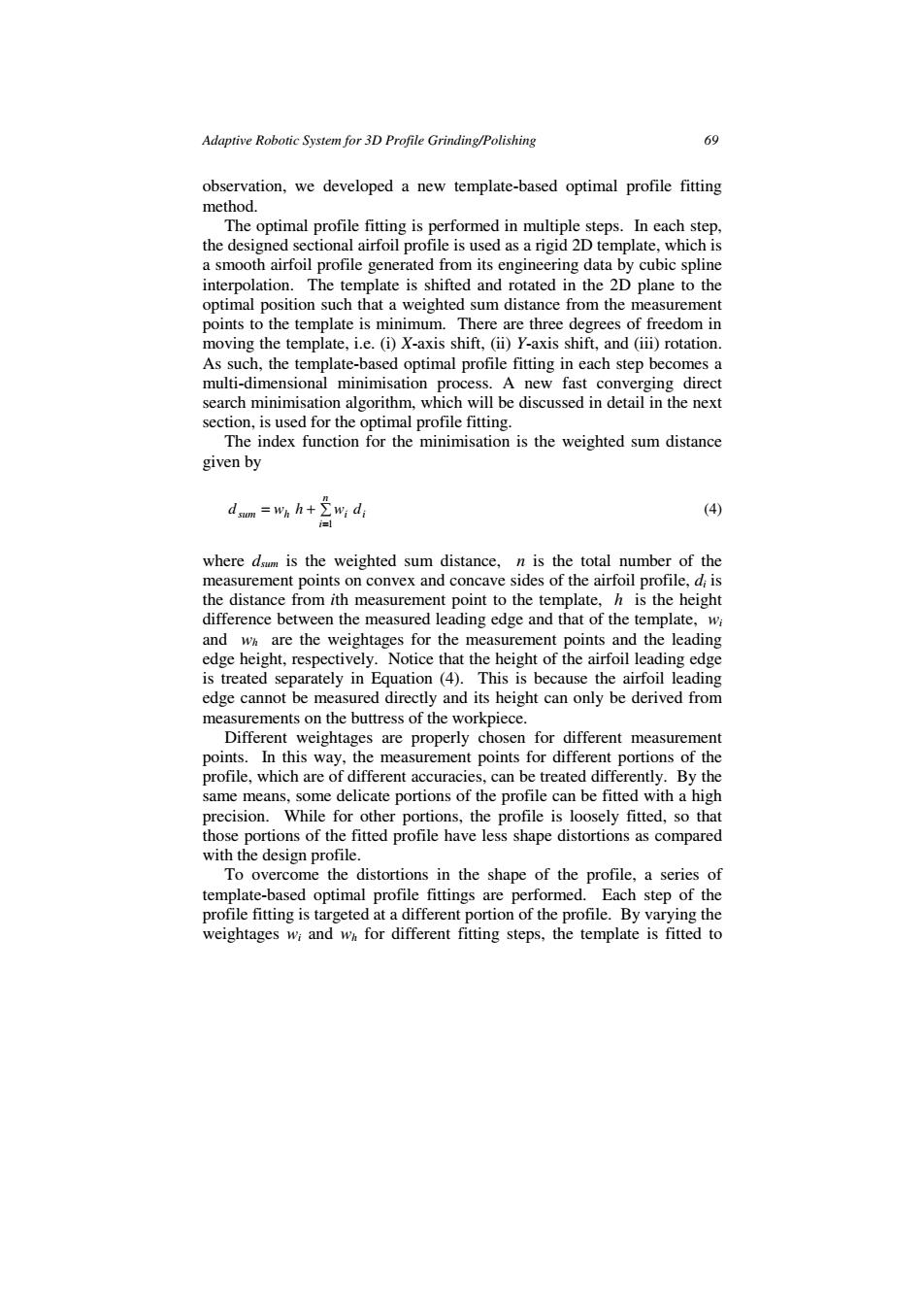正在加载图片...

Adaptive Robotic System for 3D Profile Grinding/Polishing 69 observation,we developed a new template-based optimal profile fitting method. The optimal profile fitting is performed in multiple steps.In each step, the designed sectional airfoil profile is used as a rigid 2D template,which is a smooth airfoil profile generated from its engineering data by cubic spline interpolation.The template is shifted and rotated in the 2D plane to the optimal position such that a weighted sum distance from the measurement points to the template is minimum.There are three degrees of freedom in moving the template,i.e.(i)X-axis shift,(ii)Y-axis shift,and (iii)rotation. As such,the template-based optimal profile fitting in each step becomes a multi-dimensional minimisation process.A new fast converging direct search minimisation algorithm,which will be discussed in detail in the next section,is used for the optimal profile fitting. The index function for the minimisation is the weighted sum distance given by dsum=hw:d (4) i=l where dsum is the weighted sum distance,n is the total number of the measurement points on convex and concave sides of the airfoil profile,di is the distance from ith measurement point to the template,h is the height difference between the measured leading edge and that of the template,wi and wh are the weightages for the measurement points and the leading edge height,respectively.Notice that the height of the airfoil leading edge is treated separately in Equation (4).This is because the airfoil leading edge cannot be measured directly and its height can only be derived from measurements on the buttress of the workpiece. Different weightages are properly chosen for different measurement points.In this way,the measurement points for different portions of the profile,which are of different accuracies,can be treated differently.By the same means,some delicate portions of the profile can be fitted with a high precision. While for other portions,the profile is loosely fitted,so that those portions of the fitted profile have less shape distortions as compared with the design profile. To overcome the distortions in the shape of the profile,a series of template-based optimal profile fittings are performed.Each step of the profile fitting is targeted at a different portion of the profile.By varying the weightages wi and wh for different fitting steps,the template is fitted toAdaptive Robotic System for 3D Profile Grinding/Polishing 69 observation, we developed a new template-based optimal profile fitting method. The optimal profile fitting is performed in multiple steps. In each step, the designed sectional airfoil profile is used as a rigid 2D template, which is a smooth airfoil profile generated from its engineering data by cubic spline interpolation. The template is shifted and rotated in the 2D plane to the optimal position such that a weighted sum distance from the measurement points to the template is minimum. There are three degrees of freedom in moving the template, i.e. (i) X-axis shift, (ii) Y-axis shift, and (iii) rotation. As such, the template-based optimal profile fitting in each step becomes a multi-dimensional minimisation process. A new fast converging direct search minimisation algorithm, which will be discussed in detail in the next section, is used for the optimal profile fitting. The index function for the minimisation is the weighted sum distance given by = + ∑ = n i sum h ii d w h w d 1 (4) where dsum is the weighted sum distance, n is the total number of the measurement points on convex and concave sides of the airfoil profile, di is the distance from ith measurement point to the template, h is the height difference between the measured leading edge and that of the template, wi and wh are the weightages for the measurement points and the leading edge height, respectively. Notice that the height of the airfoil leading edge is treated separately in Equation (4). This is because the airfoil leading edge cannot be measured directly and its height can only be derived from measurements on the buttress of the workpiece. Different weightages are properly chosen for different measurement points. In this way, the measurement points for different portions of the profile, which are of different accuracies, can be treated differently. By the same means, some delicate portions of the profile can be fitted with a high precision. While for other portions, the profile is loosely fitted, so that those portions of the fitted profile have less shape distortions as compared with the design profile. To overcome the distortions in the shape of the profile, a series of template-based optimal profile fittings are performed. Each step of the profile fitting is targeted at a different portion of the profile. By varying the weightages wi and wh for different fitting steps, the template is fitted to